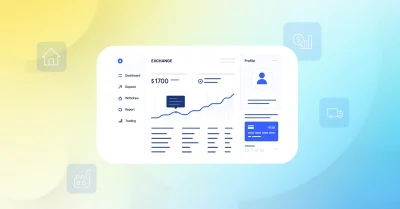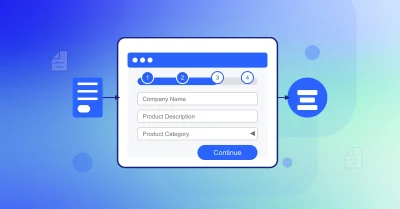The history of trade extends to more than 150,000 years back, and it kept evolving throughout centuries. The first transaction started with two people exchanging consumable goods of different shapes and quantities, until the creation of the first known coin currency changed the way we valuated goods, almost 5,000 years ago. And from goods being exchanged in-person to the creation of the first local street marketplace, where trading was conceived as one of the very first forms of conducting business.
The evolution of trading never stopped, and the mechanisms of trading kept changing from one era to another. Small in-person type of exchanges evolved to include large wholesale-like transactions. And local street marketplaces grew into different models, such privately-owned shops, up until to what we know in our modern day as retail stores.
Transition from organic walk-in conversions to personalized customer acquisition
The growth of such retail stores had always been fueled by consumer demand and was highly influenced by geography, such as densely populated areas that meant higher conversion rates. This was the success recipe for retailers over the past decades, where their operating model was dependent on large numbers of transactions. According to Forbes’ Mary Allen, some consumer electronics retailers operated on margins as low as 2% but were able to make sufficient profits through volume.
The expectancy of making large volumes of transactions while relying on walk-in conversions had significantly dropped post-COVID-19, if not flattened. Fry’s Electronics shutdown served as a wake-up call to the industry, indicating the need to innovate and develop new ways of enabling consumers to find the products they need, and even uncover the need for new products and services that would make their life more convenient without having to be physically present in a retail store.
According to a recent retail study conducted by Infosys, more than 86% of consumers indicated that personalized recommendations highly influenced their buying decisions. With very little margins in hardware and almost no room to differentiate against competition, consumer electronics retailers are realizing the need to keep evolving and personalizing the way they approach consumers, cross-sell different products, and provide post-sales services more conveniently.
The consumer relationship continuum effect
An ideal world for a brand is when their consumers are not reactively approaching them to fulfill the demand for a product, but when their consumers become brand advocates and proactively promote them to their network without any external motivation. This is influenced by the relationship the brand manages to build with the consumers over time.
Since electronics tend to have the longest refresh cycle among other products, it was harder for retailers to reach these consumers as frequently as expected. A consumer is expected to visit a grocery store once a week but visit a consumer electronics retail store once a year. Having had such a small window, consumer electronics retailers are studying and implementing subscription-based models better than others. This is increasing their frequency of communicating with their customers, reducing financial blockers as appliances no longer have to be paid for in advance, and increasing convenience.
Continuously communicating is key to build a sustainable relationship with consumers. Subscription-based services allow retailers to connect with their consumers 12 times more every year and increase their average customer lifetime value. One of the successful models is BestBuy’s Total Tech Support, a comprehensive support service with more than one million subscribers in the first year. Moreover, BestBuy offers their consumers the ability to bundle their products with monthly-based warranty and protection services. These changes are enabling BestBuy to yield higher profits, communicate and engage with consumers more, and improve their ability to cross-sell and upsell different plans and services.
The future of the consumer electronics retail industry is being reshaped with these significant changes that are helping retailers change the way they sell, make higher margins, increase customer acquisition and retention, and succeed like never before.
Becoming a services-centric organization
Consumers are easily adapting subscription-based models as they had been introduced to leasing years back. Consumers understand the flexibility they have when paying in smaller installments, rather than large upfront payments. Subscription-based models bring more than just flexibility in pricing structures. They transform how companies combine different products and services as a part of a recurring offer. This is helping retailers improve their customer ownership, significantly increase their average order value as well as the margins they are able to make on a span of 3-5 years, and eventually enables the consumer with far more convenience.
Boulanger, a French consumer electronics retailer, was able to take that model ten steps ahead. With consumers introduced to leasing models on handheld devices in the past few years, Boulanger implemented a broader anything-as-a-service model on their catalog and made it easier for their consumers to adopt. They were able to bundle their devices along with warranty, installation, and repair services in a monthly-based subscription fee. This was not limited to handheld phones or tablets as other competitors did, but expanded beyond that to include professional cameras, televisions, coffee machines, and many more.
There are hundreds of different consumer electronics retailers across Europe, where each of them is able to supply the same devices and appliances to consumers at ease. What made Boulanger unique was the way they packaged their value-added repair and maintenance services, along with warranty and guarantee services, on top of the products they sell at a simple two-digit subscription fee on monthly basis. These services-led bundles enabled Boulanger to attract more consumers, helped increase their operating margins, and dramatically increased their average order value.
Transformation brings a fresh new perspective
The transformation the as-a-service economy is bringing to the game, changing the dynamics of the industry, and changing the way large retail giants plan and operate. Fueled by the pressure and disruption the pandemic is bringing to the consumer electronics retail landscape, COVID-19 was way more influential than the evangelism efforts for digital transformation over the past years yet continues to bring to show that change creates innovation, improvement, and growth. Other consumer electronics retailers that are still deciding on their transformation must understand that to further grow and differentiate themselves among competition. Joining Fry’s Electronics shutdown queue is not far from any consumer electronics retailer if transforming their business is not a priority on their roadmap.
Get in touch with CloudBlue to learn how we are helping consumer electronics retailers offer a wider array of offerings through bundled solutions, device as a service offering, and open marketplaces. For additional information, read how consumer electronics retailers can achieve even greater growth by maximizing customer convenience and expanding their catalog of solutions and services offering.













